Potential Output: Concepts and Measurement - Department of Labour
Potential Output: Concepts and Measurement - Department of Labour
Potential Output: Concepts and Measurement - Department of Labour
You also want an ePaper? Increase the reach of your titles
YUMPU automatically turns print PDFs into web optimized ePapers that Google loves.
Darren Gibbs 95<br />
estimates suggest that a negative output gap existed in March 1992, with the<br />
more intuitively plausible yl1 measure suggesting that a negative output gap <strong>of</strong><br />
around 1.5 percent <strong>of</strong> GDP remained in the 1994 March quarter.<br />
Capital input related approaches<br />
Two techniques <strong>of</strong> relating solely capital inputs to output were applied. The first<br />
approach, similar in nature to that used to derive yl1 above, was to relate<br />
deviations in actual from potential output to deviations in capacity utilisation<br />
from historical norms. The capacity utilisation series used was that collected in<br />
the Quarterly Survey <strong>of</strong> Business Opinion (produced by the New Zeal<strong>and</strong><br />
Institute <strong>of</strong> Economic Research).<br />
The second approach used was the output/capital ratio approach discussed<br />
in section 4 which relies on the assumption <strong>of</strong> a stable proportional relationship<br />
between the stock <strong>of</strong> capital <strong>and</strong> potential output. Annual capital stock estimates<br />
for the non-government sector (excluding dwellings) produced by the Research<br />
Project on Economic Planning (Philpott, 1994) were interpolated to produce<br />
quarterly capital stock estimates through to March 1993; <strong>and</strong> capital stock data<br />
for the remaining year <strong>of</strong> the sample were estimated from SNA data with the<br />
rate <strong>of</strong> depreciation set at 1.8% per quarter. 13<br />
Figure 4 illustrates the estimated potential output series derived from applying<br />
the above techniques (yk1 <strong>and</strong> yk2), <strong>and</strong> the corresponding output gaps.<br />
As the figures illustrate, the two estimates are highly correlated. The yk1<br />
measure suggests that the economy has been operating at above potential since<br />
1993. Also note that yk2 is similar to the trend through peaks estimates in that<br />
the estimated output gap is by construction always negative. Both series suggest<br />
that the degree <strong>of</strong> spare capacity has declined sharply over the last two years.<br />
The production function approach<br />
The previous two approaches related potential output to either some measure <strong>of</strong><br />
labour input or some measure <strong>of</strong> capital input. By contrast, the production<br />
function approach relates potential output to both labour <strong>and</strong> capital inputs, <strong>and</strong><br />
by so doing should yield better estimates <strong>of</strong> potential output.<br />
Only one potential output series was estimated using this technique. The<br />
functional form chosen for the estimated production function was the constant<br />
elasticity <strong>of</strong> substitution (CES) function. The estimated function was <strong>of</strong> the<br />
following form:<br />
⎡<br />
LF E H<br />
Q= PWA• ⎛ ⎝ ⎜ ⎞<br />
⎟ • ⎛ PWA⎠<br />
⎝ ⎜ ⎞<br />
⎟ • ⎛ −ρ<br />
⎛<br />
LF⎠<br />
⎝ ⎜ ⎞⎞<br />
⎢α⎜<br />
⎟⎟ + − •<br />
⎝<br />
E ⎠⎠<br />
⎣⎢<br />
( 1 α)( QCU K)<br />
1<br />
ρ<br />
−ρ<br />
⎤<br />
⎥<br />
⎦⎥<br />
13<br />
This rate was chosen based on previous work at the Reserve Bank (See Brooks <strong>and</strong><br />
Gibbs, 1991).



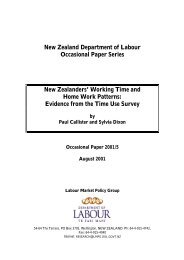

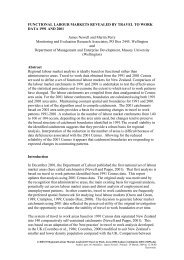

![a note on levels, trends, and some implications [pdf 21 pages, 139KB]](https://img.yumpu.com/27285836/1/184x260/a-note-on-levels-trends-and-some-implications-pdf-21-pages-139kb.jpg?quality=85)


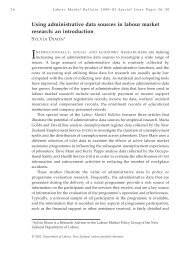
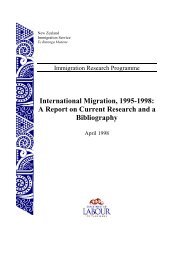

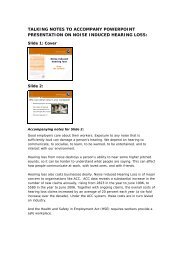
![Labour Market Trends and Outlook - 1996 [pdf 18 pages, 94KB]](https://img.yumpu.com/27285764/1/184x260/labour-market-trends-and-outlook-1996-pdf-18-pages-94kb.jpg?quality=85)

